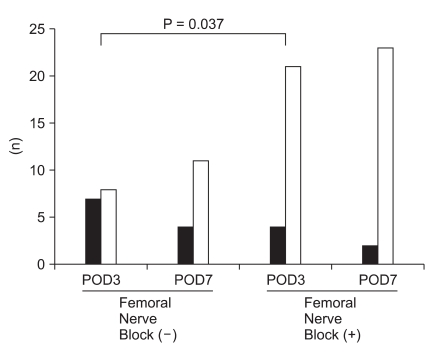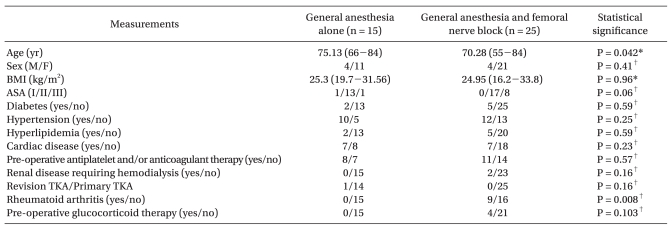1. Bauer KA, Eriksson BI, Lassen MR, Turpie AG. Steering Committee of the Pentasaccharide in Major Knee Surgery Study. Fondaparinux compared with enoxaparin for the prevention of venous thromboembolism after elective major knee surgery. N Engl J Med 2001; 345: 1305-1310. PMID:
11794149.


2. Turpie AG, Bauer KA, Eriksson BI, Lassen MR. Fondaparinux vs enoxaparin for the prevention of venous thromboembolism in major orthopedic surgery: a meta-analysis of 4 randomized double-blind studies. Arch Intern Med 2002; 162: 1833-1840. PMID:
12196081.


3. Gogarten W. The influence of new antithrombotic drugs on regional anesthesia. Curr Opin Anaesthesiol 2006; 19: 545-550. PMID:
16960489.


4. Asakura Y, Tsuchiya H, Nieda Y, Yano T, Kato T, Takagi H. Deep vein thrombosis: how long will it remain? J Anesth 2010; 24: 490-491. PMID:
20213144.


5. Asakura Y, Yano T, Takagi H, Tsuchiya H, Kato T. The incidence of development of motor blockade is concentration-dependent, and most studies regarding the continuous FNB after total knee arthroplasty used 0.2% to 0.3% ropivacaine. J Arthroplasty 2010; 25: 836PMID:
20381286.

6. den Heijer MD, Koster T, Blom HJ, Bos GM, Briet E, Reitsma PH, et al. Hyperhomocysteinemia as a risk factor for deep-vein thrombosis. N Engl J Med 1996; 334: 759-762. PMID:
8592549.


7. Niki Y, Matsumoto H, Hakozaki A, Mochizuki T, Momohara S. Rheumatoid arthritis: a risk factor for deep venous thrombosis after total knee arthroplasty? Comparative study with osteoarthritis. J Orthop Sci 2010; 15: 57-63. PMID:
20151252.


8. B├╝ller HR, Davidson BL, Decousus H, Gallus A, Gent M, Piovella F, et al. Fondaparinux or enoxaparin for the initial treatment of symptomatic deep venous thrombosis. Ann Intern Med 2004; 140: 867-873. PMID:
15172900.


9. Sharrock NE, Ranawat CS, Urquhart B, Peterson M. Factors influencing deep vein thrombosis after total hip arthroplasty under epidural anesthesia. Anesth Analg 1993; 76: 765-771. PMID:
8466014.

10. Sharrock NE, Brien WW, Salvati EA, Mineo R, Garvin K, Sculco TP. The effect of intravenous fixed-dose heparin during total hip arthroplasty on the incidence of deep-vein thrombosis: a randomized, double-blinded trial in patients operated on with epidural anesthesia and controlled hypotension. J Bone Joint Surg Am 1990; 72: 1456-1461. PMID:
2254352.


11. Abdel-Salam A, Eyres KS. Effects of tourniquet during total knee arthroplasty: A prospective randomized study. J Bone Joint Surg Br 1995; 77: 250-253. PMID:
7706340.


12. Woolson ST. Intermittent pneumatic compression prophylaxis for proximal deep venous thrombosis after total hip replacement. J Bone Joint Surg Am 1996; 78: 1735-1740. PMID:
8934490.


13. Sharrock NE, Haas SB, Hargett MJ, Urquhart B, Insall JN, Scuderi G. Effects of epidural anesthesia on the incidence of deep-vein thrombosis after total knee arthroplasty. J Bone Joint Surg Am 1991; 73: 502-506. PMID:
2013588.


14. Asakura Y, Kandatsu N, Kato N, Sato Y, Fujiwara Y, Komatsu T. Ultra-sound guided sciatic nerve block combined with lumbar plexus block for infra-inguinal artery bypass graft surgery. Acta Anaesthesiol Scand 2008; 52: 721-722. PMID:
18419732.

15. Hu S, Zhang ZY, Hua YQ, Li J, Cai ZD. A comparison of regional and general anaesthesia for total replacement of the hip or knee; A meta-analysis. J Bone Joint Surg Br 2009; 91: 935-942. PMID:
19567860.


16. Clayton RA, Gaston P, Watts AC, Howie CR. Thromboembolic disease after total knee replacement: Experiences of 5100 cases. Knee 2009; 16: 18-21. PMID:
19008109.


17. Singelyn FJ, Verheyen C, Piovella F, Van Aken HK, Rosencher N. EXPERT Study Investigators. The safety and efficacy of extended thromboprophylaxis with fondaparinux after major orthopedic surgery of the lower limb with or without a neuroaxial or deep peripheral nerve catheter: The EXPERT Study. Anesth Analg 2007; 105: 1540-1547. PMID:
18042845.


18. Wang CJ, Wang JW, Weng LH, Hsu CC, Lo CF. Outcome of calf deep-vein thrombosis after total knee arthroplasty. J Bone Joint Surg Br 2003; 85: 841-844. PMID:
12931802.


19. Pellegrini VD Jr, Langhans MJ, Totterman S, Marder VJ, Francis CW. Embolic complications of calf thrombosis following total hip arthroplasty. J Arthroplasty 1993; 8: 449-457. PMID:
8245990.


20. Gottlieb RH, Widjaja J, Mehra S, Robinette WB. Clinically important pulmonary emboli: Does calf vein US alter outcomes? Radiology 1999; 211: 25-29. PMID:
10189449.


21. Matta F, Singala R, Yaekoub AY, Najjar R, Stein PD. Risk of venous thromboembolism with rheumatoid arthritis. Thromb Haemost 2009; 101: 134-138. PMID:
19132199.
















